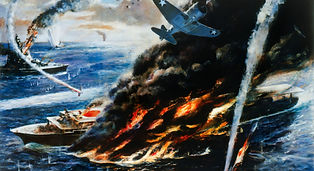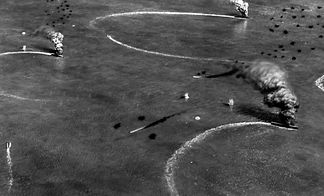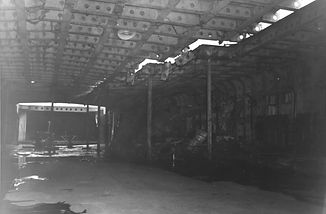On The Role Of Doctrine At Midway
Art Of Japanese Light Aircraft Carrier Soho after being hit by American Dive Bombers At The Battle Of The Coral Sea


Photo of the SBD Dauntless Scout/Dive Bomber

Picture of Akagi, Kaga, Soryu in flames after being attacked by dive bombers

Japanese Battleship Yamato, generally considered to be the flagship of the Imperial Japanese Navy

Picture of the Hangar of a Japanese Aircraft Carrier
Introduction
In the Pacific Theater of World War Two, the turning point of the war between the United States and Japan was the Battle of Midway. While many factors contributed to the American victory in this battle, one of the primary factors in determining the outcome was the superior doctrine that the United States followed and executed. The United States Department of Defense defined this doctrine as the basis for how all of the armed forces personnel operate, which proved to be very significant at the Battle of Midway. Specifically, its implementation in terms of attack strategy, organizational flexibility, and innovation is all included in the plans of engagement. At the same time, the Japanese Imperial Navy's doctrine, particularly in terms of its deployment of forces, reconnaissance, including intelligence, and aircraft handling, was inferior to what the United States was executing. As a result, it not only hampered their war-making capabilities but also contributed to their defeat.
DOCTRINE, RECONNAISSANCE & STRIKING FIRST
The United States Navy, in close association with its ally, the Royal Navy, benefited from learning about the importance of advanced scouting, the speed of attack, the quick recovery of attack aircraft, and the meticulous coordination and planning of its air groups. Led by Admiral Joseph M. Reeves, the American Carrier groups adopted the “deck park” system, which allowed for aircraft to be in reserve, ready to launch as needed. Further, the navy also emphasized fleet exercises, reconnaissance training, and innovation by developing specialized aircraft that can handle both reconnaissance and combat.
Meanwhile, while the Japanese Imperial Navy did maintain aircraft that were efficient and moved speedily with experienced pilots, very little input and prioritization was put into evolving the carrier structure and strategy, which meant that a heavy focus relied on massive offensive attacks but far less on reconnaissance, speed of launching aircraft, and sorties. This was a crucial mistake because, as the American doctrine proved, winning carrier battles heavily relied on efficient reconnaissance because locating the enemy and striking first was essential to victory.
The Americans found that statistically, the carrier group that strikes first is ultimately and usually the victor. It is much more challenging to defend against a surprise air attack on a carrier, especially without prior warning or a functioning radar system. Specifically, at the Battle of the Coral Sea, which was a lead-up to Midway, the Americans struck first, and because of this, they sank a Japanese light aircraft carrier. This experience was important in furtherance of their doctrine as it placed an even greater emphasis on having aircraft that can both scout and perform dive bombing runs in its missions.
At the Battle of Midway, the American doctrine proved itself even further as American dive bombers from the USS Enterprise and Yorktown discovered the Japanese carriers while refueling, before the Japanese reconnaissance aircraft, which were in much smaller numbers. The Americans had struck gold with their doctrine because the innovation of developing planes that could scout and attack too gained them valuable and precious time over the Japanese navy. Japanese war captain and Pearl Harbor first wave leader Mitsuo Fuchida later admitted that the Japanese neglect of reconnaissance vs American efficiency in this area was a determining factor in the outcome of the carrier war because it also meant that the Japanese did not properly protect their carrier groups.
Aircraft Handling and Strike Efficiency
Another part of the successful American doctrine was how the Americans handled their aircraft. Much thought was put into making sure and then building that the aircraft carriers could hold as many aircraft as possible and ironically, even though Japan had more aircraft carriers than the Americans did at the Battle of Midway (4 to 3), the American carriers held more planes on its carriers so the firepower was matched. Furthermore, the Americans were far more versatile in their aircraft deployment, with planes that included fighter squadrons, scouting squadrons, bombers, and torpedo bombers, which gave them opportunities to branch out and increased their chances of locating and attacking the Japanese carriers first. Japanese aircraft were mainly focused on attack and were not nearly as versatile. What it also meant was that the Americans could deploy multiple types of squadrons for attack simultaneously, which proved decisive at the Battle of Midway, as the USS Enterprise demonstrated by destroying three of the four Japanese carriers.
FORCE DEPLOYMENT & STRATEGIC FLEXIBILITY
The American doctrine showed greater flexibility than the Japanese when it came to structuring the protection of its carriers. Instead of the old and conventional method of protecting one’s carrier group with battleships, the Americans focused on ships that offered far greater speed and evasiveness. As an example, Admiral Nimitz separated his carriers into two groups at the Battle of Midway, protected by cruisers and destroyers, which proved to provide much faster cover than the slower battleships left behind at Pearl Harbor. Meanwhile, the Japanese left their four carrier group in the conventional box formation, which meant that they were very close together, far more vulnerable, and much easier to spot. Once spotted so close together, the Americans were able to attack these carriers simultaneously. Ironically, the Japanese navy, led by Admiral Yamamoto, still believed that battleships commanded the seas and kept those ships in reserve, ready to trap if their carrier groups were defeated. This antiquated strategy proved costly because, ironically, those battleships never entered the Battle of Midway because the Americans destroyed the Japanese carriers, fulfilled their mission, and withdrew. In hindsight, the Japanese plan of attack to trap the faster American fleet in one swoop proved to be unrealistic.
FLIGHT DECK OPERATIONS
A major difference in the American doctrine vs the Japanese enemy was in how the flight deck was managed. The Americans packed, serviced, and armed their aircraft on the flat deck of their carriers, preferring speed. This would be compared to a pit at a racetrack, where the crew moves as quickly as possible to get the racecar back onto the track. The Japanese preferred to service their aircraft below deck, as had been done in the past, which took significantly more time. In an aircraft carrier engagement, which the Battle of Midway symbolized, World War II changed sea battles; speed, not custom, was what helped win the day for the Americans. While the Americans could service and prepare their aircraft on carriers on their flight decks in minutes, the Japanese needed 45 minutes of uninterrupted time to prepare a launch. The difference in doctrine meant victory in the Battle of Midway and helped bring about victory in the Pacific War, too.
